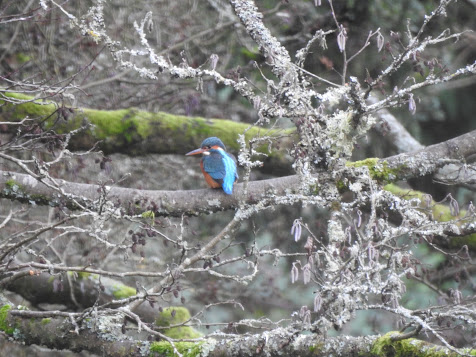I had expected this posting to be the traditional review of the year kind of thing, but today's visit to Morton Bagot was too impressive to ignore.
It began unpromisingly. Heavy showers had dampened Dave's enthusiasm by the time I finally arrived. Nevertheless we took advantage of a brief cessation in the bloody awful weather and headed northwards from Netherstead.
At the scrape field the scrapes were awash. There was enough water for 47 Mallard to dabble in, and enough pasture for a Stonechat and about 10 Meadow Pipits. We chose not to enter, but instead to make our way to the flash field. A large flock of thrushes was assessed as containing 230 Redwings, 40 Starlings, and at least 20 Fieldfares. The scope was erected but no amount of scanning could produce anything rarer.
Looking across the flash field we could see the usual Teal (Dave counted 27), and a less usual flock of Greylag Geese. At some point in the next half hour I thought I saw a smaller goose among these geese. We wisely headed back up the slope to scope the furthest flash. The geese were feeding to the right of the flash and were hard to see properly. I had in mind Mark Islip's sighting of a White-front at Arrow Valley Lake earlier in the week.
From a higher vantage point we were in a position to at least count the Greylags (37...Dave again). At last I picked out a smaller, dark goose among the Greylags. For ages it wouldn't put its head up, or would be obscured by other geese. I was hogging the scope, only giving Dave his turn when I got a clear enough view to call it a White-fronted Goose. We switched positions, Dave having his chance to see the bird, while I wondered how best to get a shot of it.
Eventually I headed down the slope, closer to the trees, from where I had a big enough gap to give me a chance. Without the scope it was much harder to find the bird, but eventually I did so.
 |
| "Russian" White-fronted Goose with three Greylags |
Dave was far behind me on top of the rise, anxious not to lose the goose. This was unfortunate, because it meant he didn't hear the Water Rail which squealed from the marsh.
Around this time I received some Twitter messages from Mark Williams and Andy Harris. Evidently Mark had visited Morton Bagot on Friday, and on his way home had discovered a Short-eared Owl near Wawensmere Road. He hoped it might still be in the area.
I went back to encourage Dave to join me at a slightly better position half way down the slope. From here the views of the geese were better, although I only managed one more shot of the White-front with its head up.
 |
| White-fronted Goose |
As far as we could see, the bird lacked black belly markings and didn't have a very clear white "front", leading us to conclude it was a juvenile/first-winter bird. I rang Mark and he confirmed that the Arrow Valley Lake bird was also a juvenile. Clearly it was the same goose.
The reason I'm going on a bit about this bird is that there has only been one here before. That was an adult I had seen in flight in November 2011, twelve years ago.
With the rain pepping up again we decided to head back, crossing the middle of the fields, hoping to flush the Short-eared Owl. We didn't succeed, but did kick up several Snipe and a Woodcock.
The White-fronted Goose becomes the 143rd species on my Circle year-list, and now is the time for a quick canter through the year's highlights.
The best find was a moth! The Clancy's Rustic in my garden trap in late September was the first for both Warwickshire and the wider West Midlands. Butterflies also got in on the act, with Brown Hairstreaks at Morton Bagot and in my garden in August/September.
 |
| Clancy's Rustic |
 |
| Brown Hairstreak in the garden |
As far as birds go, there wasn't really a true stand-out. There were plenty of good birds though. The Kittiwake we found dead in February was the only species which was new for Morton Bagot, but a Goshawk in August was the first since 2012, and today's White-fronted Goose was the first since 2011. Other quality birds at Morton Bagot were two Quails (June and September), a Wood Sandpiper in August, and a Garganey in September.
Further afield the Nordic Jackdaw near Hockley Heath earlier this month was my first in the West Midlands, the Tundra Bean Goose of dubious provenance at Shortwood Roughs was a Circle Patch tick, and three Rock Pipits at Earlswood joined some good twitched birds there; Common Scoters, Little Gull, Mediterranean Gull, and Sandwich Tern. The last of these also being a Circle patch tick for me.
 |
| Sandwich Tern at Earlswood |
I would just like to wish everyone a Happy New Year, and hope we all find plenty of good birds to keep us going in 2024.































